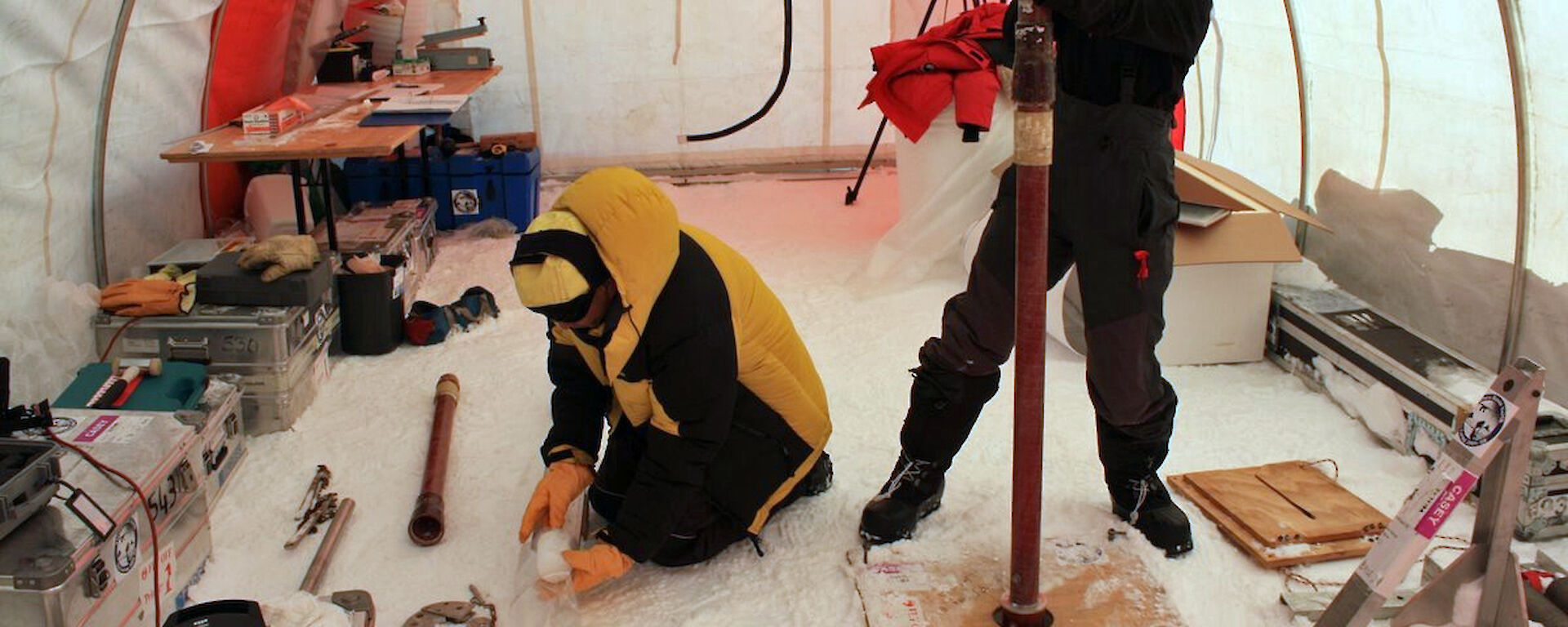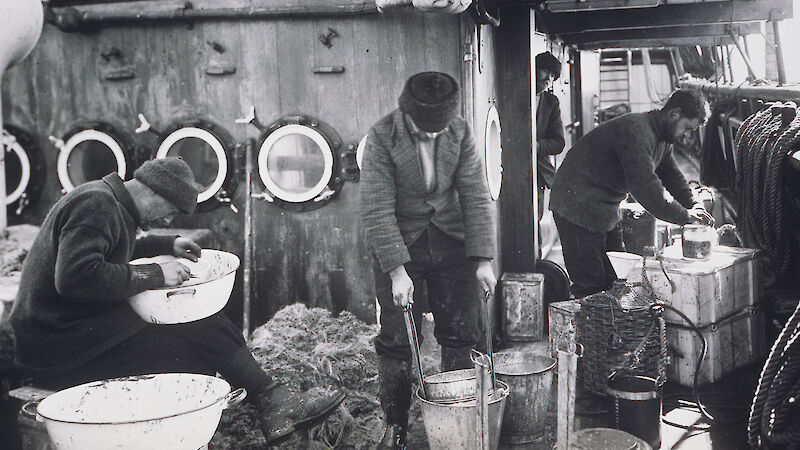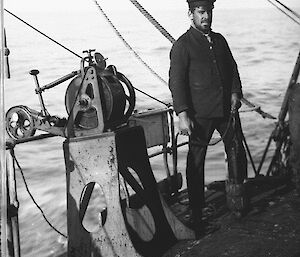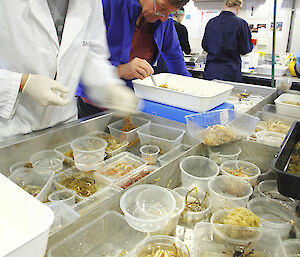As a geologist, Mawson’s fascination with Precambrian rocks in the Flinders Ranges of South Australia led him to join Shackleton’s 1907–09 Nimrod expedition to investigate Antarctic glacial geology. His experiences on that expedition inspired him to systematically explore and study Antarctica during the Australasian Antarctic Expedition (AAE) and subsequent British Australian New Zealand Antarctic Research Expedition (BANZARE).
The AAE’s scientific effort was based in four places. Three of these were on land at Macquarie Island, Cape Denison, and the Shackleton Ice Shelf in Antarctica — with sledging parties taking the research inland. The fourth was on the rolling deck of the former whaling ship Aurora.
In Antarctica and on Macquarie Island, collections and/or observations were made in investigative fields including biology, cartography, geology, glaciology, geomagnetics, meteorology, medicine and atmospheric research. Among the expedition’s achievements were the first satisfactory photographs of the aurora australis, quality data on the location and movement of the south magnetic pole, collections of seabirds and their eggs, radio transmission of meteorological data from Antarctica via Macquarie Island to Melbourne, and mapping of Macquarie Island and parts of the Antarctic coastline and inland Antarctica.
While the shore parties were to explore the land and ice around their bases, Captain John King Davis and his men were tasked with exploring a much larger area in the Southern Ocean. The 1872–1876 Challenger expedition had been the major Antarctic oceanographic venture up to then, but the seas crossed by the AAE had never before been subjected to dedicated marine science study.
Under Davis’s supervision in London, the Aurora was transformed into a ship of science. From the British naval hydrographer John Parry, Davis secured deep-sea sounding record books, along with advice on the use of Aurora’s two sounding machines. Subsequent mapping of the sea floor south of Tasmania was the most systematic yet attempted. The exercise resulted in the discovery of a large undersea plateau to the south and south-east of Tasmania now known as the South Tasman Rise.
To obtain biological specimens from the ocean depths, a steam windlass and deep sea dredging equipment were fitted at the end of Aurora’s first Antarctic voyage, in 1912. The ship carried a variety of trawls and nets designed for sampling selectively from different parts and depths of the ocean.
Mawson also had John Hunter — the main biological collector — dredging for biological specimens, with considerable success, in the shallow waters of Commonwealth Bay. His collection from the voyage included six specimens of the rare Ross seal and a large collection of external and internal parasites from birds, seals and fish. The specimens and sea floor detritus brought aboard opened up a whole new world of glacial ebbs and flows and evolving life forms and ecosystems down the ages.
The early 1930s saw Mawson’s BANZARE to east Antarctica, from Enderby Land to Oates Land, collecting scientific data on land and sea, including geology, meteorology, zoology and botany. Publication of the expedition’s reports ran to 13 volumes and was not completed until 1975, indicating the scope and scale of the scientific work undertaken on this expedition. As the 1930s ended and war embraced the world, scientific study of Antarctica was forced to take a back seat.
When peace resumed Douglas Mawson returned to his quest to promote the Antarctic and a scientific expedition aboard the Wyatt Earp was assembled and a team of scientists recruited. Among them was Phillip Law, a physics lecturer at Melbourne University. His task was to coordinate the program of scientific research and to make observations on cosmic rays from the ship. Meteorology and geology were to be the main focus for the scientific program, as they were the priorities of a Government which already sensed that Australia’s climate was profoundly influenced by its proximity to Antarctica. And so it was that in 1947 Australia’s National Antarctic Research Expedition (ANARE) was born.
By the time the International Geophysical Year (IGY 1957–58) was proposed, Australia had been involved in scientific research in Antarctica for almost 80 years, albeit on an opportunistic and uncoordinated basis. IGY made Antarctica the focus for concerted and collaborative research and for this purpose a number of nations built research stations. Although Australia’s Mawson station preceded the IGY by three years, many new Antarctic stations were opened during its course, including the United Kingdom’s Halley station, Japan’s Syowa station and several stations opened by the former Soviet Union. IGY was characterised by a focus on the physical composition of Antarctica, its ice cap and the atmosphere above it (Australian Antarctic Magazine 12: 4–5, 2007). Australian biological research had to wait quite a few years before it was treated seriously.
In December 1956 Kista Dan sailed for the Vestfold Hills (where Davis station was subsequently established in 1957). Scientific work centred on geophysics and Antarctica’s structure, the ice sheet, and upper atmospheric physics, and it was at this time that glaciology entered the program. Phillip Law was of the view that Australia produced more valuable scientific data than almost any other nation on account of the fact that ‘we were the only ones, apart from the British, who’d had enough experience beforehand to set up a decent scientific program’.
Government support for IGY science was a turning point for Australia, despite the prevailing view that during the pre-IGY days Australian interest in the Antarctic served sovereignty and not scientific objectives. Development of science was much advanced by both Mawson and Law being scientists of high standing. Each in his own way ensured that Australian science in Antarctica would become an increasingly valuable currency in the Antarctic Treaty and its associated instruments.
Australian contributions to upper atmospheric physics, geology and glaciology, as well as its support of the Commonwealth Trans-Antarctic Expedition (1955–58), enabled it to be regarded as a significant force in Antarctic science. IGY changed the world’s perspective about Antarctica by introducing the central theme of the Antarctic Treaty that Antarctica is to be used for the peaceful pursuit of science. The Treaty enshrines the principle of scientific cooperation and collaboration in Articles II and III and these remain defining characteristics of Antarctic science. In the decades following IGY and particularly since 1991, when the Antarctic Treaty Consultative Meeting declared 1991–2000 as the Decade of International Scientific Cooperation, collaborative research has increased 13-fold, while the number of scientific papers published world-wide has doubled. If science has become the currency of Antarctica, Australia has played a strong role in maintaining its value.
Australia’s current Antarctic research program has certain characteristics that set it apart from those of other long-established Antarctic nations and which are materially responsible for the significant contribution Australia has made to the Antarctic Treaty System. Although it is one of the oldest national programs, the intellectual environment in which the program has evolved has not been stable. For the first 20 years of its existence (1948–1968) the Australian Antarctic Division was a part of the Department of External Affairs, which had little core interest in science. Between 1968 and 1987 the Antarctic Division’s home changed several times, sometimes quite rapidly, within various manifestations of the Department of Science. However, a focus on science was maintained and, with the advent of the Antarctic Science Advisory Committee (ASAC) in the early 1980s, financial support was provided to enable participation of university scientists in the program, boosting the Antarctic science workforce. ASAC is a committee established by and reporting to the Minister charged with overseeing Australia’s Antarctic research program. From July 1987 to the present day the Antarctic Division has been in the Environment portfolio rather than the Science portfolio, but a focus on science continues.
Australia’s program of scientific research in Antarctica was initially driven largely by the enthusiasm of those in charge, though it is fair to say that the world’s fascination with physics provided the driver for most research until the 1970s. First the Australian Academy of Sciences and later ASAC provided advice on the strategic directions for the science program, but it was not until 1995 that the first science strategic plan was prepared. Prior to 1995 much fundamental work was conducted on the ice sheet and cryosphere generally, setting the foundations for the present focus on high-latitude climate science. Early work on penguins (mainly after 1970) and in marine biology, laid important foundations for Australia’s commitment to the Convention for the Conservation of Antarctic Marine Living Resources (CCAMLR).
The first strategic plan for science was developed in 1995. Subsequent plans in 2000, 2005 and 2011 sharpened the focus on those areas of science of direct relevance to the Government’s positions on environmental protection, Southern Ocean fisheries science and cetacean biology and conservation. These are areas over which the current Department of Sustainability, Environment, Water, Population and Communities has policy carriage. Strong research themes now include high latitude climate science, marine ecosystem conservation in support of CCAMLR, and environmental protection in support of the agenda of the Committee for Environmental Protection.
In the future we can expect to see the development of remote sensing technologies replacing and supporting field observations that have characterised Antarctic science since Mawson’s time. Satellites, which started to observe Antarctica only a little over 30 years ago, are allowing observations to be made across vast swathes of Antarctica, with sensors that can accurately measure surface elevation, surface temperature, surface roughness, sea ice extent and concentration, and track the movement of icebergs.
Advances in microelectronic devices, which can be affixed to seals and penguins, are now enabling significant advances to be made in understanding ocean currents and water properties. Small video cameras mounted on the heads of seals allow detailed examination of seal diet and hunting behaviour, with only minimal intrusions while the apparatus is fitted and retrieved. New sensors will enable new variables to be observed, such as the pattern of patchiness of biological productivity in relation to seal feeding locations. Such devices will likely become smaller, such that the day will not be far away before they can be fitted to small fish and even invertebrate species.
The next few decades will see the emergence of ever bigger science with increasing numbers of agencies and research teams collaborating and contributing equipment and expertise. While issues of sovereignty and the politics of Antarctica are never far away, the world has woken up to the fact that Antarctica is no longer a remote, far-away place visited only by adventurers and explorers, but is very much the canary in the global coal mine and also the powerhouse behind much of the world’s weather and ocean quality. Australia can be truly proud of its record of scientific research in Antarctica, which has established the basis for much of what is yet to come.
Information about AAE science in this article was collated from The Home of the Blizzard website. The subsequent text (from BANZARE to today) was modified from a chapter written by Professor Michael Stoddart, former Chief Scientist, Australian Antarctic Division (1998–2009), for the new book Australia and the Antarctic Treaty System: 50 Years of Influence, published by UNSW Press in September 2011.






